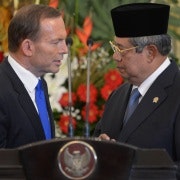Unions leave Shorten on a sticky picket
Bill Shorten’s blaming of the Abbott government for the death of the car industry and condemning the royal commission into union corruption were entirely predictable positions.
But they also highlight the major challenges ahead of the opposition leader as he positions himself on key economic issues and attempts to loosen the constraints imposed by his union past.
It’s easy politics for Shorten to target the government over the exit of Holden and Toyota. Losing this particular industry and the high cost in jobs make it a hot button issue. And advocating more government assistance fits into Labor’s tradition.
At least, into one strand of that tradition. In the Hawke-Keating period, Labor established another tradition, when it promoted extensive change in the economy – including dismantling protection.
For a while, Labor turned its back on those years but then re-embraced them.
Shorten has to ask himself: does he want to stand for economic reform, as Hawke and Keating did?
Doing that is harder than putting 'oppositionist' politics first and foremost, in the mould of Kim Beazley and, of course, Tony Abbott. It would be especially tricky given that the interventionist approach has strong followers in Labor.
But if Shorten’s aim is to cut a credible figure in the years ahead, he will have to look to the economics. And as Paul Keating puts it: “good policy is good politics”.
Interestingly, on the issue at hand, voters don’t necessarily default to giving more aid to the auto industry. This week’s Essential poll showed more people against than in favour of production subsidies for motor vehicle manufacturing: 47 per cent to 36 per cent. Labor voters were more likely than Coalition voters to approve support, 45 per cent to 32 per cent.
In parliament on Tuesday, Shorten resorted to the line that “this North Sydney-based government does not understand manufacturing in the southern states of Australia. They have never seen a Victorian or South Australian job they would ever fight for, other than their own marginal seat MPs.” It sounded like a twist on the so-called 'class' swipes made in the Gillard-Swan time.
But it is a simplistic attack that doesn’t do justice to Shorten’s own economic knowledge. Shorten’s attention should be on the creation of a forward-looking industry policy, because the end of the auto sector will be a fait accompli. Production is due to finish in 2017 by the time of the next Labor government.
Even more difficult and important is how Shorten deals with the union connection.
Aware that Labor had to put up an alternative to the royal commission, he proposed a police taskforce. It was clear however that, despite the government’s political motives for the royal commission, Labor’s arguments against it (lack of criminal charges out of the previous Cole commission, the high cost) sounded weak.
Shorten has robustly condemned corruption in unions, but his opposition to a royal commission undermined the strength of what he was saying.
The commission holds dangers for Labor because of its institutional and financial links to the unions; the union backgrounds of so many leading parliamentary figures, including Shorten; and the current personal networks.
Shorten now should be seen to take the line of letting the cards fall where they will in the investigations ahead.
More generally, cementing himself as an alternative prime minister requires drawing a boundary line between himself and the unions. No small task, but one better tackled early in his leadership.
Kevin Rudd had little time for the unions and paid a price; Julia Gillard was too beholden to them and that had a cost too. Shorten is of the union movement, and so will try to use it. But it will try to use him too, and there lies the risk for him.
Tuesday’s Newspoll found that after a solidly increasing satisfaction rating last year (as people took their first look at him as opposition leader), Shorten had gone backwards, with a fall from 44 per cent in December to 35 per cent. Abbott was stable on 40 per cent. Labor’s vote had fallen but, on a two-party basis, the ALP was ahead of the Coalition 51-49 per cent. In the Essential poll, also released on Tuesday, Shorten’s approval was down 5 points to 30 per cent from mid January (Abbott’s approval fell 6 points to 41 per cent).
Although it is the start of the term, the coming months will be crucial for Shorten. It’s not just the voters who will be getting a handle on him in his new role. His party will be too. In areas such as Labor’s economic approach and its stance vis-a-vis the unions, this is the best time for Shorten to set his tone and establish his authority.
Michelle Grattan does not work for, consult to, own shares in or receive funding from any company or organisation that would benefit from this article, and has no relevant affiliations.
![]()
This article was originally published on The Conversation. Read the original article.













